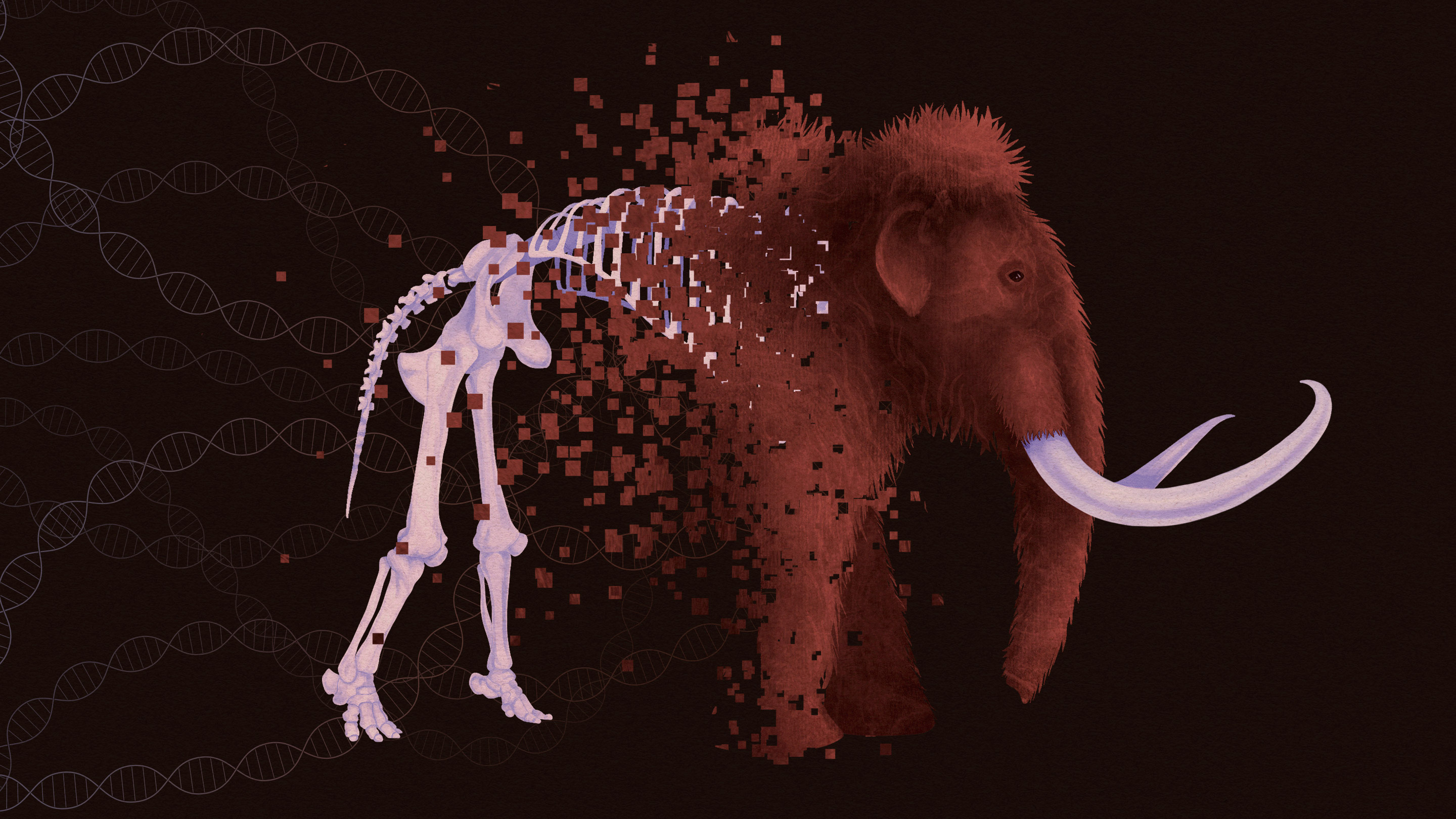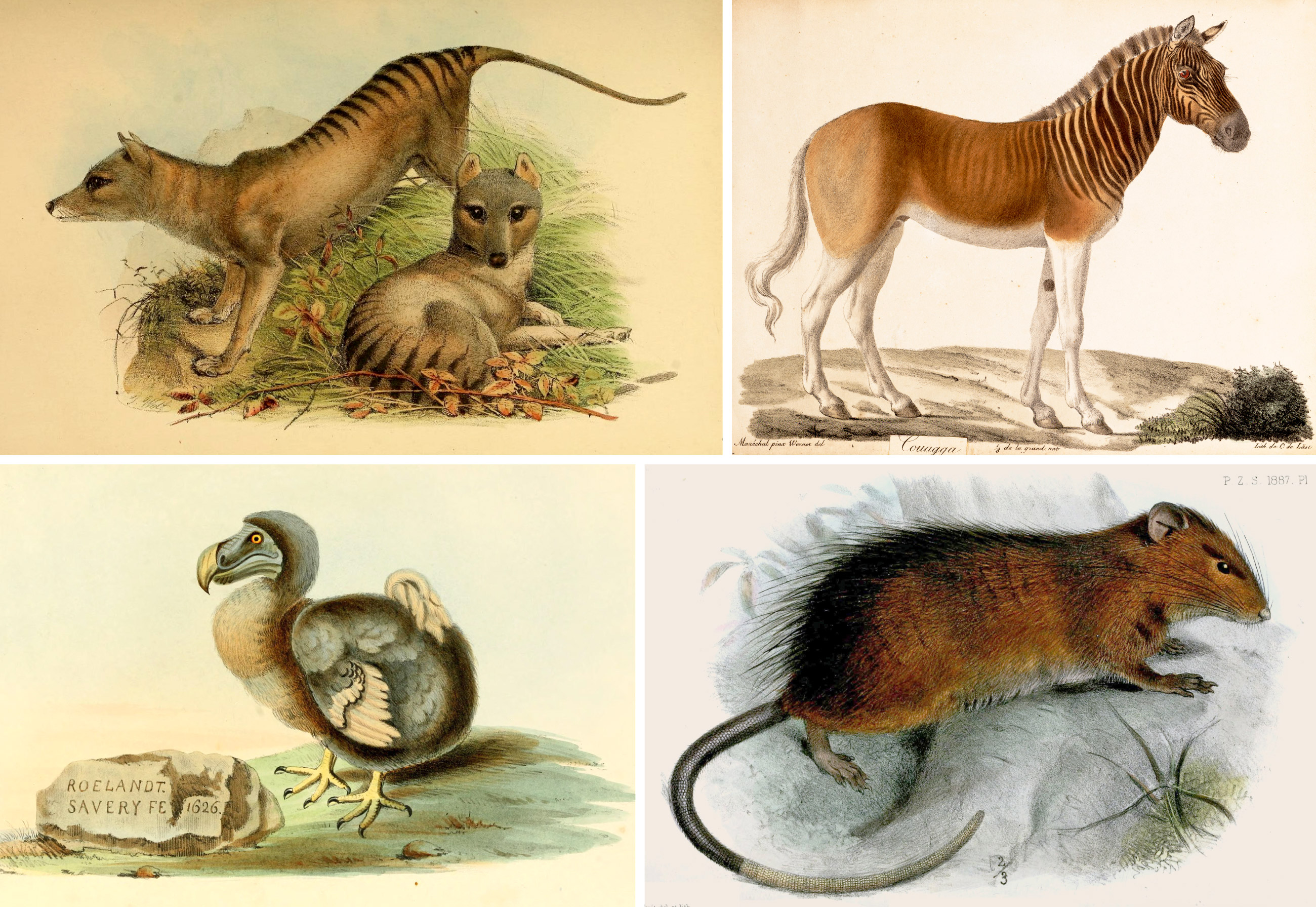Why ‘De-Extinction’ Is Impossible (But Could Work Anyway)

A famous de-extinction project led by the geneticist George Church of Harvard University aims to bring back woolly mammoths — not exactly as they once were but as mammoth-elephant hybrids.
Kristina Armitage/Quanta Magazine
Introduction
For scientists studying de-extinction — the ambitious effort to resurrect extinct species — a paper that appeared in Current Biology in March was a sobering reality check. Thomas Gilbert, a genomics researcher and professor at the University of Copenhagen, led a team of researchers who tested the feasibility of de-extinction by sequencing the genome of the Christmas Island rat, a species that went extinct in the late 19th or early 20th century.
“Look, this is like the best-case scenario,” Gilbert said. The samples of DNA from the extinct species were relatively new and well preserved, and the extinct rat was very closely related to the standard brown Norway rat, for which there is abundant DNA reference data. This was a far cry from trying to figure out the DNA of some jungle cat from the Pleistocene, let alone a dinosaur. Reconstructing the extinct rat’s genome should have been relatively simple.
Yet despite their best efforts, the scientists were unable to recover nearly 5% of the Christmas Island rat’s genome. Many of the missing genes were related to immunity and olfaction, two highly important functions for the animal. “It’s not just the irrelevant stuff that you’re not going to get back,” Gilbert said. “And so what you’ll end up with is nothing like what went extinct.”
Though the results from Gilbert’s group are new, in many ways they underscore something that many scientists have understood for a long time. “The biggest misconception about de-extinction is that it’s possible,” said Beth Shapiro, a professor of ecology and evolutionary biology at the University of California, Santa Cruz.
Ben Novak, a lead scientist for Revive & Restore, one of the front-running non-profit organizations in the de-extinction effort, readily acknowledges this. “You can never bring something back that is extinct,” he said. But for Novak and most other de-extinction researchers, creating a proxy instead of the real thing is not a problem — it’s the goal.
Most de-extinction researchers aren’t looking to resurrect a charismatic ancient beast just for the sake of putting it into the nearest zoo for viewer pleasure. Rather, they are aiming to create proxies for educational or conservation purposes, such as to fill the void left by their extinct counterparts in ecosystems or to boost the numbers of modern-day endangered species.
Piecing Together a Genome
The challenges facing de-extinction start with DNA, the genomic molecule that makes the hope of de-extinction possible. In the Jurassic Park novel and films, dinosaur DNA from more than 65 million years ago could be extracted from a mosquito preserved in amber. But in real life, DNA is too delicate to survive that long: It has a half-life of only around 521 years.
Even in well-preserved tissues left over from recently extinct species, the contained DNA is often fragmented. “And because those fragments are tiny, it’s impossible to actually reassemble them [digitally] like puzzle pieces into the entire picture that they used to be,” Novak said.
In particular, it’s not always clear what the order of the genes should be on the reconstructed chromosomes. Those details matter because studies of living species have shown that slight alterations in gene order can have significant effects on behavior and other traits. De-extinction researchers typically use the genome of a closely related living species as a guide, but that approach has limitations.
“Even if we could get 100% of its genetic code, we would still be creating an organism that has the same gene order and chromosome count as its living relative,” Novak said. And as Gilbert’s new work makes clear, getting close to all of the genetic code may often be impossible.

Many extinct species intrigue biologists, but not all extinct species lend themselves to de-extinction efforts. Shown here (clockwise from top left) are the extinct thylacine, the quagga, the Christmas Island rat and the dodo bird.
(Left to right, top to bottom) Proceedings of the Zoological Society of London; Iconographia Zoologica; Smithsonian Libraries; Proceedings of the Zoological Society of London 1887
Gilbert’s work speaks to the difficulties of de-extinction through genetic engineering, a popular approach favored by researchers such as George Church, a professor of genetics at Harvard University who is leading a project aimed at bringing back the woolly mammoth of prehistory. With a large recent funding boost from the startup Colossal, Church is hopeful that they’ll make headway in the next decade or so by genetically editing mammoth genes into Asian elephants, a closely related living pachyderm.
But the de-extinction field encompasses more than genetic engineering. Using an approach called selective back-breeding, some groups are restoring ancient traits from extinct species by selectively breeding individuals that still carry the genes for them. For instance, the Tauros Program aims to back-breed modern cattle to make them more like their pre-domesticated ancestors, the aurochs, and the Quagga Project in South Africa is selecting for zebras that still have genes from the quagga, a subspecies hunted to extinction in the 19th century.
Still, even if these genetic engineering and selective breeding efforts succeed, they can only create a kind of hybrid rather than a purely resurrected species.
The closest you can get to an exact genetic replica of an extinct species is a clone created from a living or preserved cell from that species. Scientists don’t have useable cells from woolly mammoths, dodos, the Tasmanian tiger or most other species that are hyped up in the realm of de-extinction, but they do from some more recently extinct species. In 2003, researchers used cloning to bring back the bucardo, a species of wild goat, using a modern goat as a surrogate parent and egg donor. The baby bucardo, the only extinct species to ever be cloned, died after only seven minutes because of a lung malformation.
But even if cloning is someday more successful, according to the International Union for Conservation of Nature (IUCN), it could also lead to proxies “that differ in unknown and unpredictable ways from the extinct form.” For example, researchers may not know everything about potential epigenomic differences affecting DNA activity or the microbiome needed to support the species’ health. They also may not be able to recreate the exact learning environment in which the original species was reared, which could cause the behavior of the de-extinct species to deviate from that of the original.
Despite these differences, Novak said, “from an evolutionary standpoint, a clone is an authentic, or ‘true’, de-extinct organism.” In fact, although cloning is officially included in the IUCN guidelines and some other researchers would disagree, Novak doesn’t think cloning should even be considered de-extinction but rather a “true recovery.”
Functional Equivalents
The problems that riddle the field don’t dissuade de-extinction researchers. For them, a good proxy or functional equivalent of a lost species may be good enough. “I don’t actually know anyone who said we have to get a perfect copy of anything,” said Church. The practical goal of the woolly mammoth project he’s leading is to help endangered Asian elephants adapt to the frigid environments of the Arctic tundra.
“Make sure people don’t think they’re going to get a mammoth, because they’re not,” said Gilbert, who is not involved in that research. They will instead get a “hairy elephant” that can live in the cold.
Mammoth-elephant hybrids could be relocated to places such as Pleistocene Park, a large area of tundra in Russia where scientists are trying to restore the much more biodiverse and climate-friendly grasslands ecosystem it once was, when large grazers including mammoths populated the area. By trampling the soil and allowing cold air to seep in, the mammoth hybrids could in theory slow the melting of permafrost and the release of greenhouse gases that are warming the globe. The team also hopes that in the process, they can rescue the endangered elephant species by placing them in a large open area free from human conflict.
Similarly, Novak is working to resurrect the extinct passenger pigeon and the heath hen as genetically engineered hybrids of modern species, in the hope that they might help to restore their respective ailing ecosystems and motivate restoration efforts. The San Diego Zoo is trying to save the northern white rhino, a species that is functionally extinct because two females are the only ones left in the world. The zoo’s scientists are developing stem cells that could differentiate into northern white rhino sperm and eggs, and any resulting embryos might be carried to term by surrogate southern white rhinos.
“I’m excited about [de-extinction] and keep talking about it and keep doing interviews about it, not because I think we really are going to get a mammoth — I don’t think we will,” Shapiro said. “But because the path to getting us there is so important for conservation of living species.”
And if resurrected species are introduced into the wild, some of de-extinction’s successes may go even further in the long run. “If we get our proxies close enough,” Novak said, “evolution itself is probably going to converge them even closer to the original form than we can actually succeed in doing.” That is, if the forces that felled the original species don’t render their replacements extinct too.



